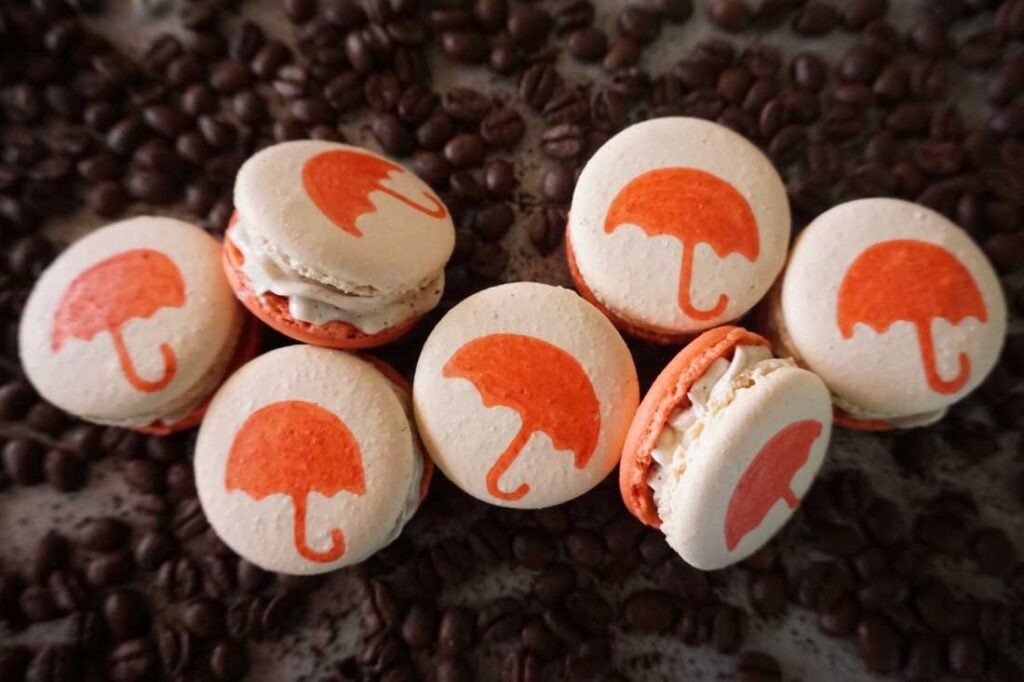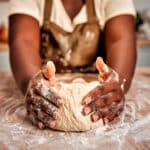In the past three years, we’ve witnessed elegant pivots, contortions and leaps of faith in nearly every sector of business. There’s perhaps no better example of this than the pastry world, where sliding into someone’s DMs often equates to spontaneous income.
Add to that website orders and pop-up events, and the traditional dessert model has moved from brick and mortar to creative side hustles—and, often, full-time gigs—where the chefs call the shots.
Becoming a pastry chef during the pandemic
The entrepreneurial path was a lifelong dream for Jessica Minghi of Borough Chocolates, who began selling bonbons from her Brooklyn apartment after being laid off from her job at New York’s famed Restaurant DANIEL at the start of the pandemic.
“The covers kept getting less and less,” she recalls. “Then, we were told not to come back to work. It happened overnight.”
Throughout her 14-year culinary career, she always thought she’d ease into building a business, but the pandemic accelerated her timeline. She used her savings to buy chocolate-making equipment and began taking photos of her bonbons, which friends shared on Instagram.
“I’m blessed because I live in New York,” Minghi says. “A guy on my block was selling pizza out of his window, and a lot of people in the city were delivering around town. I would never be able to do what I do in any other city.”
Turning a passion into a profession
St. Louis bartender Jeffrey Moll Jr. has dabbled in breadmaking as a hobby for several years. But the pandemic’s pause on his full-time work kickstarted his passion into a business he still maintains as a flourishing side hustle.
At his weekend-only Upper Crust Bread operation, he offers pickup and delivery of a variety of breads, including focaccia, pain de campagne, farro-oat porridge and sunflower wheat.
“I’ve always found myself attracted to positions with more autonomy,” Moll says. “But it gets intense on the weekends. I do the bar prep two days a week and bartend two days a week. On Friday, I get up at 4 a.m. to get my leaven started, bake everything off Saturday for pickup, and on Sunday morning, I bake off orders and deliver them, then go to work at Planter’s House.”
Finding your niche as a pastry chef
Although it may seem obvious that doing what you love is the best option, it’s often a financially challenging one. But it’s one that drives Seattle pastry chef Aliyah Davis every day in her business, Black Magic Sweets.
Davis, who has a background in clinical psychology, admits she has never been happier than she is working for herself, but she never expected her side hustle to turn into a full-time gig.
“I was working at a bread shop, and when the pandemic hit, it closed down,” she says. “I was supposed to be leaving for Wales the following fall and had saved up some money for that, and that’s when I decided to dive in to my business and make it a full-time thing.”
Luckily, she had already done some beta testing as a student at Seattle Culinary Academy. Next, she homed in on her niche.
“We had a pastry case where we’d sell things to the rest of the students at Seattle Central College,” she says. “I started making reindeer and snowmen macarons, and they sold quickly. I loved making exactly what I wanted to make, so I started painting macarons. I was also doing tea [flavors] and floral infusions, and people really loved them, so I went from 15 items on a pop-up menu to focusing on the macarons. I started selling my hand-painted macarons to different tea and coffeehouses across the city, building my little community with mostly women- and queer-owned businesses.”
How to become a pastry chef entrepreneur
All three of these chefs have found their sweet spot as entrepreneurs. Here are their top five tips for starting your own pastry chef gig.
1. Diversify as much as possible.
Davis, who gets a lot of her income from wholesale, does pop-ups and special orders for birthdays, anniversaries and weddings. She plans to offer live baking classes and bonus online content, where paid members can watch videos on demand.
Moll, who does sandwich pop-ups at local cafes and coffee shops and sells add-on products such as fermented vegetables, nut butters and rye chocolate chunk and black sesame cookies, says bread alone won’t pay the bills. “Places that are just bakeries don’t make money unless they’re doing something else to supplement it,” he says.
2. Don’t be afraid to start as a side hustle, then grow.
Moll, who maintains a time-consuming side hustle while working full-time, says his lifestyle requires some pretty finicky space shuttle-launch conditions to pan out correctly.
“I don’t have the luxury of failing if something goes wrong,” he admits. “I would one day like this to be bigger, but doing it inside my home is nice because the rent is paid, and I have everything I need here. But it would be nice having an oven where I can make more than two loaves of bread at a time.”
3. Know your limits, and find the technology that fits for you.
“I can shut my online store off at any point and have a good idea of what my capacity is and what I can responsibly fulfill,” Moll says. “Square has been a great tool for having that automation and not getting overwhelmed. I’ve got friends who do all their ordering through Instagram direct messaging, and I would be worried about too many orders coming in. Square helps me sleep at night.”
4. Be nimble, and keep pivoting when needed.
At the start of the pandemic, e-commerce was Minghi’s bread and butter, but because chocolate is heat sensitive, she had a limited shipping window in the warmer months. After being written about in the Washington Post, the demand for her bonbons was so overwhelming, she was able to raise the funds for a doll-size brick and mortar in Brooklyn’s Greenpoint neighborhood, showcasing her bite-size creations behind glass, like edible jewels.
“I started thinking about wholesale but felt like if there was a window and people could see [my products], it would sell itself,” she says. “Having the connection to the community has been incredible. I was feeling so isolated during COVID, so this has been an important piece for me.”
5. Keep practicing.
“Bread and chocolate are both technical products you have to spend a lot of time with in order to get good at,” Minghi says. “To me, bonbons had a familiarity like photography. In the darkroom, you start to see something take shape. In bonbons, you get the same satisfaction. Restaurants didn’t let me do a lot of chocolate work, so I asked a lot of questions and spent years practicing.”
This article originally appeared in the March/April 2023 issue of SUCCESS magazine. Photo courtesy of Aliyah Davis











